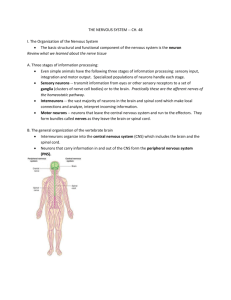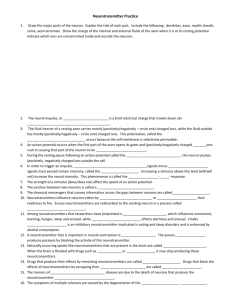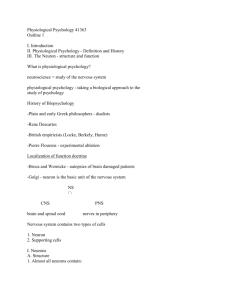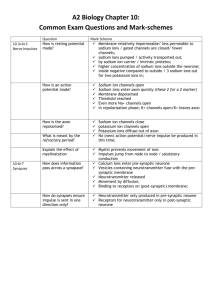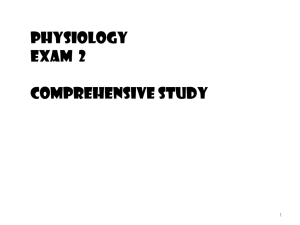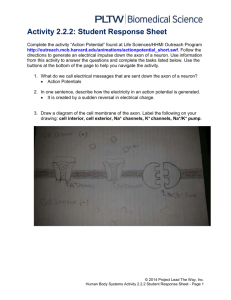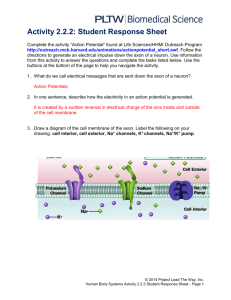THE NERVOUS SYSTEM -- CH. 48 I. The Organization of the
advertisement
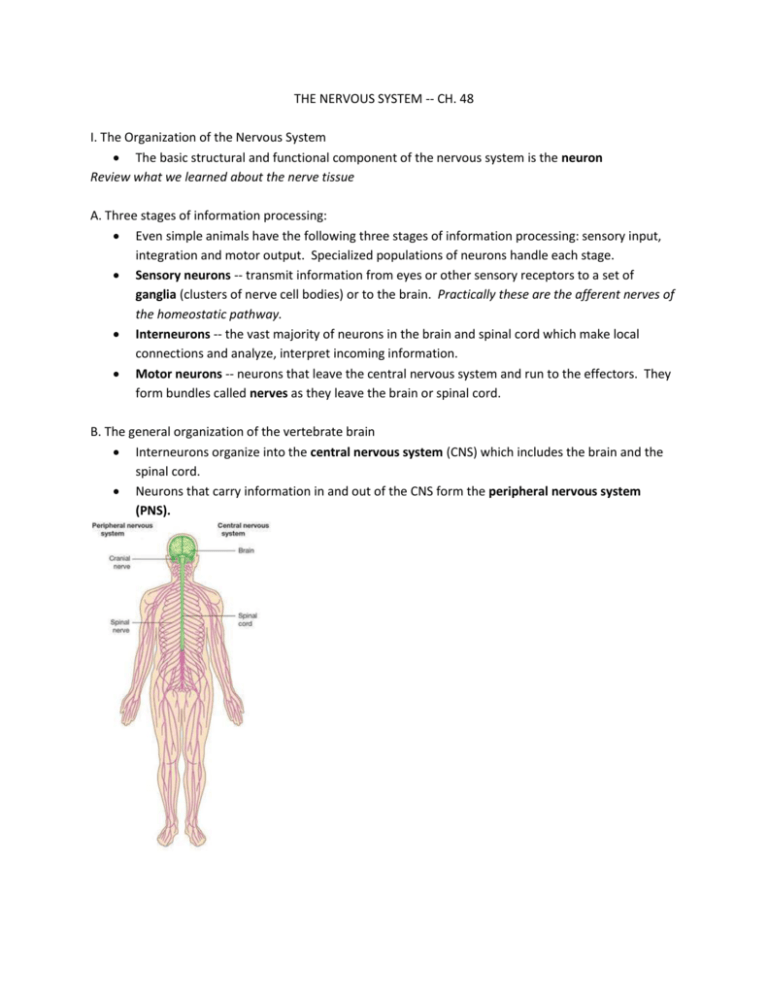
THE NERVOUS SYSTEM -- CH. 48 I. The Organization of the Nervous System The basic structural and functional component of the nervous system is the neuron Review what we learned about the nerve tissue A. Three stages of information processing: Even simple animals have the following three stages of information processing: sensory input, integration and motor output. Specialized populations of neurons handle each stage. Sensory neurons -- transmit information from eyes or other sensory receptors to a set of ganglia (clusters of nerve cell bodies) or to the brain. Practically these are the afferent nerves of the homeostatic pathway. Interneurons -- the vast majority of neurons in the brain and spinal cord which make local connections and analyze, interpret incoming information. Motor neurons -- neurons that leave the central nervous system and run to the effectors. They form bundles called nerves as they leave the brain or spinal cord. B. The general organization of the vertebrate brain Interneurons organize into the central nervous system (CNS) which includes the brain and the spinal cord. Neurons that carry information in and out of the CNS form the peripheral nervous system (PNS). II. Neuron Structure and Function As the basic unit of the nervous system, the neuron is able to receive, transmit and interpret information. Nerve impulses usually received on the dendrites or on the nerve cell body and transmitted through the axon to other cells. The transmission between two cells is done by a synapse. The synapse uses neurotransmitters -- chemical messengers to transmit messages from the presynaptic cell to the postsynaptic cell. Glia cells are also important in the nervous system. These cells nourish neurons, insulate the axon, regulate the extracellular fluid composition around the neurons. III. The Resting Potential of the Neuron Resting potential -- is the potential difference between the inside and outside of the cell membrane of any cell. A neuron, when it is not sending signals has a resting potential between -60 and -80 mV. The negative sign indicates that the inside of the cell is more negative than the outside extracellular matrix around it. This potential is mainly set up by the difference in concentration of K+, Na+ ions. There is a higher concentration of K+ ions inside the cell and a higher concentration of Na+ ions outside of the cell. This concentration difference is kept up by the Na-K ion pump. However, the membrane also has various ion channels that are very specific to transporting certain ions only. Because these ion channels for K+ are constantly open at rest, the potassium ions can freely flow out of the cell moving from the higher to the lower concentration. However, chlorine and other negative ions cannot follow, hence the negative charge inside the cell. At one point the chemical gradient of K+ ions counterbalances the electrical gradient set by the charges, so the membrane potential will not decrease to any more negative value. Only a few sodium ion channels are open so fewer sodium ions move into the cell. (intracellular recording) IV. Action Potential When neurons are active, membrane potential and membrane permeability changes very quickly because of the gated ion channels in the membrane of neurons. These channels open and close in response to stimuli. When the channels open and the membrane potential inside the cell becomes more negative than the resting potential (to about -90mV – but here the absolute value counts, the negative sign only represents the charge) the membrane is hyperpolarized. This can be caused by the outflow of positive ions or the inflow of negative ions. Depolarization on the other hand means a change of the membrane potential to a more positive value by either having an influx of positive or an outflux of negative ions (the membrane potential usually shifts to about +60mV). A larger stimulus usually causes a greater change in the permeability while a smaller potential causes a lesser change – graded potential Action potential – a sudden large change in the membrane voltage due to a very rapid opening of sodium voltage-gated channels. This occurs whenever a depolarization process reaches a particular value called a threshold (it is -55mV in mammals). Once this threshold is reached the value of the action potential is independent from the stimulus that triggers it – all-or-none response. However, these action potentials are very quick, 1-2 msec, so a cell can generate several of these in a second. The frequency of the action potential depends on the signal strength. The steps of the action potential: o At rest, most voltage-gated sodium channels are closed, some potassium channels are open but most voltage-gated ones are closed. This results in the -70mV resting potential. o A stimulus opens some sodium channels and sodium ions flow into the cell from the extracellular matrix – depolarization. If the depolarization reaches a threshold, it triggers an action potential. o Depolarization opens most voltage-gated sodium ion channels, while potassium channels remain closed, so the inside becomes more positive than the outside – rising phase of the action potential o Voltage gated sodium channels inactivate shortly after opening, stopping Na+ influx. Most voltage-gated potassium channels open, so K+ ions flow out of the cell very rapidly. This brings the membrane potential back to negative inside again – falling phase of the action potential. o Most potassium channels close quickly but some remain open and the inside becomes more negative than the resting potential – undershoot o Sodium-potassium ion pumps return the resting potential. During the time when the resting potential returns on the membrane, a second action potential cannot be initiated – refractory period. However, this refractory period is due to the inactivation of the sodium channels not to the change in ion gradients. V. Conduction of Action Potential The action potential serves as a long-distance signal by regenerating itself as it travels from the cell body to synaptic terminals of the axon. At the site, where the action potential is initiated, Na+ inflow during the rising phase creates an electrical current that depolarizes the neighboring region of the axon membrane. This depolarization in the neighboring region causes the creation of an action potential there, creating an action potential that travels down the axon to the axon terminals. The identical process guarantees that the magnitude of the action potential remains constant. Because of the repolarization of the previous section of the membrane, the action potential cannot travel backward toward the cell body. The speed of the conduction of the action potential depends on several factors: o Axon diameter – wider axons have faster conduction speed because of the lower resistance per area – this fact is widely used in invertebrate nervous systems. This is the reason why Mollusks and Arthropods have some very large axons that control muscle contraction. o The presence of a myelin sheath – produced by various glia cells that wrap around the axon in multiple layers of membranes. (Oligodendrocytes in the CNS and Schwann cells in the PNS.) These act as insulators because the lipid part of the membrane is a poor conductor. The action potential is only generated at the nodes of Ranvier where the membrane is in contact with the extracellular matrix. In between the nodes an intracellular current carries the impulse. This way of conduction (called saltatory conduction) is common among vertebrate animals. VI. Neurons Communicate With Other Cells at Synapses Information is transmitted from one neuron to another by using synapses. Electrical synapses – form very narrow gap junctions, which allow electrical current to flow directly from one neuron to another. This type of synapse is found in synapses that are associated with repetitive, fast responses. Chemical synapses – the majority of synapses use chemicals to transmit information. The axon terminal of pre-synaptic nerve cell is attached to the dendrites or cell body of the postsynaptic nerve cell. There may be hundreds of axon terminals attached to the same cell body. Each presynaptic terminal synthesizes a neurotransmitter and packages it into synaptic vesicles. Steps of a synapse: o Action potential arrives to the terminal and depolarizes its membrane. o This depolarization opens up voltage-gated Ca2+ ion channels at the end of the terminal. Ca2+ ions move into the terminal from the extracellular matrix. o The influx of calcium ions causes some of the synaptic vesicles to fuse with the cell membrane and release the neurotransmitters into the synaptic cleft. o The neurotransmitter binds with ligand-gated ion channels on the postsynaptic membrane, opening these channels. o Na+ ions from the synaptic cleft flow into the postsynaptic cell and K+ ions flow out of the cell causing an action potential to initiate. o The neurotransmitter is released from the ion channels, the channel closes and the neurotransmitter is destroyed or neutralized. http://highered.mcgrawhill.com/sites/0072495855/student_view0/chapter14/animation__chemical_synapse__quiz_1_.html VII. The Postsynaptic Potential If the neurotransmitter binds to a gated channel that carries both Na+ and K+ ions, the membrane potential inside of the membrane becomes more positive and reaches the threshold of an action potential. This is called excitatory postsynaptic potentials (EPSPs). In other cases, different neurotransmitters bind to different kind of gated channels that are permeable to only K+ or Cl-. In these cases the postsynaptic membrane hyperpolarizes and these move the membrane further from the threshold – inhibitory postsynaptic potentials (IPSPs). Unlike action potentials that are all-or-none, postsynaptic potentials are graded. Their magnitude varies depending on many factors: o The amount of neurotransmitters released o Summation of various postsynaptic potentials – postsynaptic potentials get weaker as they spread, because they are led on the nerve cell body or dendrite not the axon. For that reason one EPSP is not enough to trigger an action potential alone. Spatial summation (summing EPSPs or IPSPs that come in at different locations but at the same time), or temporal summation (EPSPs add together that come quickly one after the other on the same axon) can initiate action potential. o IPSPs and EPSPs also may cancel each other out. o The axon hillock is the integrating center of the neuron, where all incoming IPSPs and EPSPs are added up. Whenever the membrane potential on the axon hillock reaches the threshold, a membrane potential is generated that runs all the way to the axon terminal. VIII. Neurotransmitters These chemicals are organized by their structure. The major classes are acetylcholine, biogenic amines, amino acids, neuropeptides and gases. A single neurotransmitter can have many different receptors and these receptors can result in a very different transduction pathway and response in the postsynaptic cells. Important neurotransmitters: o Acetylcholine – this is the main neurotransmitter in neuromuscular synapses (synapse that forms between nerve and muscle cells) except on the heart muscle cells. This neurotransmitter generates an EPSP on the muscle cells that can result in muscle contraction. The activity of this neurotransmitter is terminated by enzymes in the synaptic cleft. In cardiac muscle, acetylcholine has inhibitory effects. Some chemicals that interfere with acetylcholine are nicotine – binds to the same receptors as acetylcholine and stimulates the postsynaptic muscle cells; botulism toxin – inhibits acetylcholine release from the presynaptic cells. o Dopanime – an amine neurotransmitter that is synthesized from amino acids. An important neurotransmitter in the brain that connect various nerve cells. There are 5 different receptors that are used to detect dopamine on the postsynaptic cells. Frequently associated with brain regions that are responsible for reward-driven learning. As a result, several highly addictive drugs such as cocaine and methamphetamine stimulate the same receptors and directly act on the dopamine system. Diseases such as Parkinson’s disease that results in tremor, impairment of muscle function is related to loss of dopamine secreting neurons. o Gamma-aminobutyric acid (GABA) – is an amino acid which is the most important inhibitory neurotransmitter, which produces IPSPs by increasing the permeability of the postsynaptic membrane to Cl- ions. IX. Organization of the Vertebrate Nervous System The brain and spinal cord of the vertebrate nervous system are tightly coordinated. The brain acts as main integrating, coordinating center and the center for memory, learning and other complex behaviors in humans. The spinal cord conveys information to and from the brain and also generates basic patterns of locomotion. The spinal cord is also important in independent coordination of reflexes -- the bodies automatic responses to certain stimuli. The reflex protects the body by triggering a rapid, involuntary response to a particular stimulus that would otherwise damage the body. Below are the steps of the knee-jerk reflex: 1. stimulus is the tapping of the tendon of the quadriceps muscle -- potential damage to that tendon. 2. sensors detect the stretch of the quadriceps muscle 3. sensory neurons carry the information to the spinal cord 4. the sensory neurons synapse with motor neurons and with interneurons 5. the motor neurons convey signals back to the quadriceps and make them contract, jerking the lower leg forward 6. the interneurons send signals to the motor neurons of the hamstring muscles 7. the motor neurons of the hamstring muscle inhibit the contraction of the hamstring muscles, so they don't resist the quadriceps. The brain and the spinal cord is derived from the embryonic nerve cord, which is hollow. During the development, this hollow cavity forms the narrow central canal of the spinal cord and the ventricles of the brain. Both of these structures are filled with cerebrospinal fluid, which is a fluid that is filtered out from the arterial blood of the brain. This fluid supplies different parts of the brain and spinal cord with nutrients, hormones and carries away waste. In mammals it also cushions the brain. The brain and the spinal cord also contain gray and white matter. Gray matter consists of mainly the cell bodies of neurons, their dendrites and unmyelinated axons. The white matter consists of the myelinated axons of bundles of neurons. The white matter in the spinal cord lies outside and the gray matter inside, while in the brain the white matter is mostly inside. This allows the brain to connect various different sections to each other by myelinated neurons.


